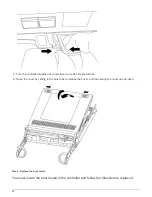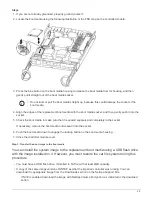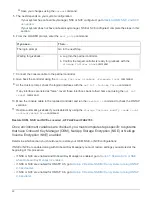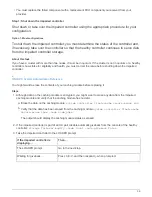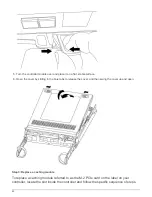
If the console
displays…
Then…
Waiting for giveback…
a. Log into the partner controller.
b. Confirm the target controller is ready for giveback with the
storage
failover show
command.
4. Move the console cable to the partner controller and give back the target controller storage using the
storage failover giveback -fromnode local -only-cfo-aggregates true local
command.
◦
If the command fails because of a failed disk, physically disengage the failed disk, but leave the disk in
the slot until a replacement is received.
◦
If the command fails because of an open CIFS sessions, check with customer how to close out CIFS
sessions.
Terminating CIFS can cause loss of data.
◦
If the command fails because the partner "not ready", wait 5 minutes for the NVMEMs to synchronize.
◦
If the command fails because of an NDMP, SnapMirror, or SnapVault process, disable the process. See
the appropriate Documentation Center for more information.
5. Wait 3 minutes and check the failover status with the
storage failover show
command.
6. At the clustershell prompt, enter the
net int show -is-home false
command to list the logical
interfaces that are not on their home controller and port.
If any interfaces are listed as
false
, revert those interfaces back to their home port using the
net int
revert
command.
7. Move the console cable to the target controller and run the version
-v command
to check the ONTAP
versions.
8. Restore automatic giveback if you disabled it by using the
storage failover modify -node local
-auto-giveback true
command.
9. Use the
storage encryption disk show
at the clustershell prompt, to review the output.
This command does not work if NVE (NetApp Volume Encryption) is configured
10. Use the security key-manager query to display the key IDs of the authentication keys that are stored on the
key management servers.
◦
If the
Restored
column =
yes
and all key managers report in an available state, go to
Complete the
replacement process
.
◦
If the
Restored
column = anything other than
yes
, and/or one or more key managers is not available,
use the
security key-manager restore -address
command to retrieve and restore all
authentication keys (AKs) and key IDs associated with all nodes from all available key management
servers.
Check the output of the security key-manager query again to ensure that the
Restored
column =
yes
and all key managers report in an available state
36







